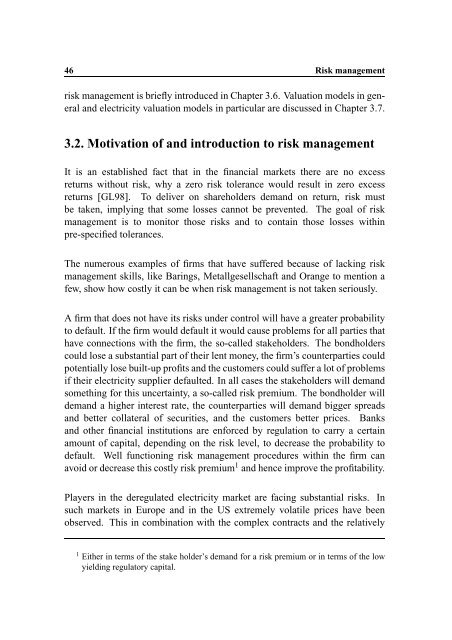Hedging Strategy and Electricity Contract Engineering - IFOR
Hedging Strategy and Electricity Contract Engineering - IFOR
Hedging Strategy and Electricity Contract Engineering - IFOR
You also want an ePaper? Increase the reach of your titles
YUMPU automatically turns print PDFs into web optimized ePapers that Google loves.
46 Risk management<br />
risk management is briefly introduced in Chapter 3.6. Valuation models in general<br />
<strong>and</strong> electricity valuation models in particular are discussed in Chapter 3.7.<br />
3.2. Motivation of <strong>and</strong> introduction to risk management<br />
It is an established fact that in the financial markets there are no excess<br />
returns without risk, why a zero risk tolerance would result in zero excess<br />
returns [GL98]. To deliver on shareholders dem<strong>and</strong> on return, risk must<br />
be taken, implying that some losses cannot be prevented. The goal of risk<br />
management is to monitor those risks <strong>and</strong> to contain those losses within<br />
pre-specified tolerances.<br />
The numerous examples of firms that have suffered because of lacking risk<br />
management skills, like Barings, Metallgesellschaft <strong>and</strong> Orange to mention a<br />
few, show how costly it can be when risk management is not taken seriously.<br />
A firm that does not have its risks under control will have a greater probability<br />
to default. If the firm would default it would cause problems for all parties that<br />
have connections with the firm, the so-called stakeholders. The bondholders<br />
could lose a substantial part of their lent money, the firm’s counterparties could<br />
potentially lose built-up profits <strong>and</strong> the customers could suffer a lot of problems<br />
if their electricity supplier defaulted. In all cases the stakeholders will dem<strong>and</strong><br />
something for this uncertainty, a so-called risk premium. The bondholder will<br />
dem<strong>and</strong> a higher interest rate, the counterparties will dem<strong>and</strong> bigger spreads<br />
<strong>and</strong> better collateral of securities, <strong>and</strong> the customers better prices. Banks<br />
<strong>and</strong> other financial institutions are enforced by regulation to carry a certain<br />
amount of capital, depending on the risk level, to decrease the probability to<br />
default. Well functioning risk management procedures within the firm can<br />
avoid or decrease this costly risk premium 1 <strong>and</strong> hence improve the profitability.<br />
Players in the deregulated electricity market are facing substantial risks. In<br />
such markets in Europe <strong>and</strong> in the US extremely volatile prices have been<br />
observed. This in combination with the complex contracts <strong>and</strong> the relatively<br />
1 Either in terms of the stake holder’s dem<strong>and</strong> for a risk premium or in terms of the low<br />
yielding regulatory capital.
















